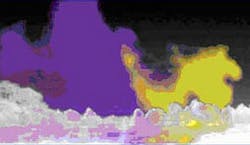Army asks industry for Lidar long-wave infrared detectors for biological and chemical agents
Officials of the Edgewood Chemical Biological Center (ECBC) at Aberdeen Proving Ground, Md., issued a sources-sought notice on Monday (W911SR-17-R-LWIR) for the Long-wave Infrared Lidar project.
ECBC researchers are looking for existing advanced-prototype, commercial off-the-shelf (COTS) or government off-the-shelf (GOTS) LWIR Lidar technologies capable of detecting chemical vapors and biological aerosols to enable chemical and biological standoff detection.
The goal is to provide a standoff detection capability in a mobile or fixed-site application at ranges as far as 1.3 miles. Army researchers are looking for COTS LWIR Lidar technologies that can detect a 10-to-100-meter-deep chemical agent vapor cloud from as far away as two kilometers.
Technologies should weigh less than 70 pounds excluding battery, gimbal, tripod, computer, and other ancillaries; take up less than two cubic feet of space; scan as quickly as 10 degrees per second; and have a wavelength of at least 8.2 to 10.7 microns.
Related: Lidar shown to detect biological agents
Technologies should be tunable to individual wavelengths with less than 0.5 second between wavelengths; have repetition rates of at least 4 Hz; be able to access raw data for assessment purposes; and be powered by a battery or shore power of 100 to 240 volts AC.
Researchers are interested in COTS LWIR Lidar technologies with algorithms that can detect chemical and biological agents in relevant militarily environments; be existing products with delivery times of less than six months; and require no design or development phase.
Companies interested should email white papers no later than 5 Sept. 2017 to the Army's Salma Khairedin at [email protected].
More information is online at https://www.fbo.gov/notices/2462064b214a543770c812725c34ccb4.
Learn more: search the Aerospace & Defense Buyer's Guide for companies, new products, press releases, and videos
